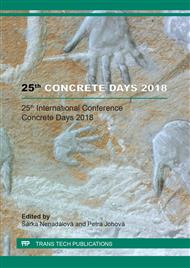p.203
p.210
p.217
p.224
p.230
p.236
p.242
p.249
p.257
Utilization of Vacuum-Formed Plastic Membranes for the Production of Lightened HPC Panels
Abstract:
This paper describes the utilization of vacuum-formed plastic membranes for the production of lightened panels made of high-performance concrete with technical textile reinforcement. The use of vacuum-formed plastic membranes is aimed to reduce the cost and increase the efficiency of production of concrete elements with highly profiled surface. Studded plastic membrane is cheap alternative to silicone or steel and while it provides slightly lower precision of manufacturing it surpasses especially the steel alternative in the terms of demoulding, since it has not sharp edges and can be easily bended.Second part of the article focuses on the limitations given by the lightening and the approach to reduce them while maintaining the reduction of material usage. The cross-section weakened by lightening in comparison to the un-lightened specimens leads to earlier development of cracks in concrete matrix and lower ultimate bending strength caused by shear failure of the lightened cross-section. The development of cracks in concrete matrix cannot be easily controlled while maintaining the same level of lightening but by addition of another layer of the reinforcement it is possible to achieve similar ultimate bending strength as in the case of elements with full cross-section and same thickness.
Info:
Periodical:
Pages:
236-241
Citation:
Online since:
June 2019
Authors:
Permissions:
Share:
Citation:


